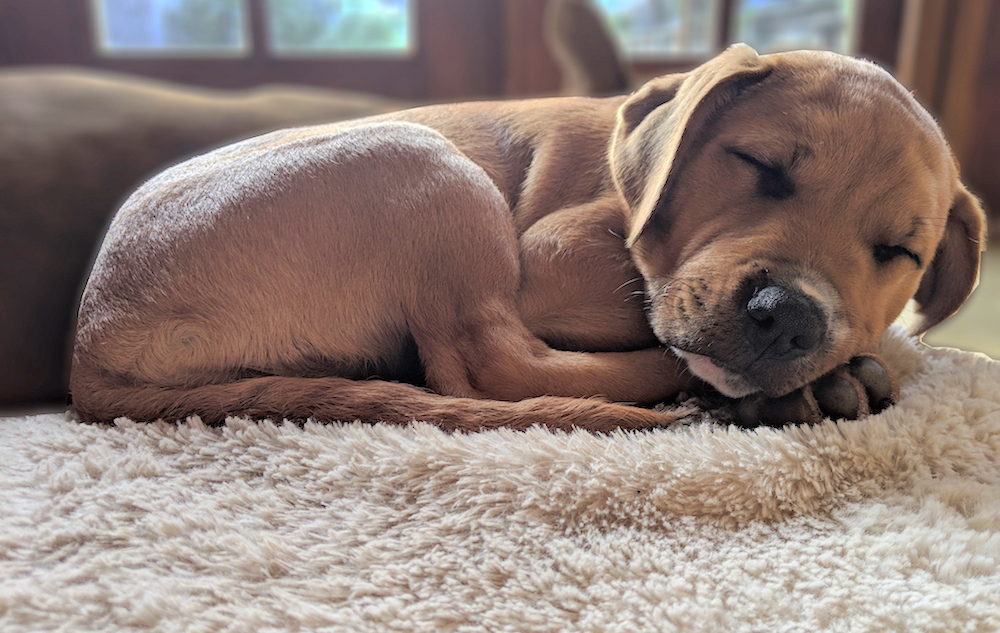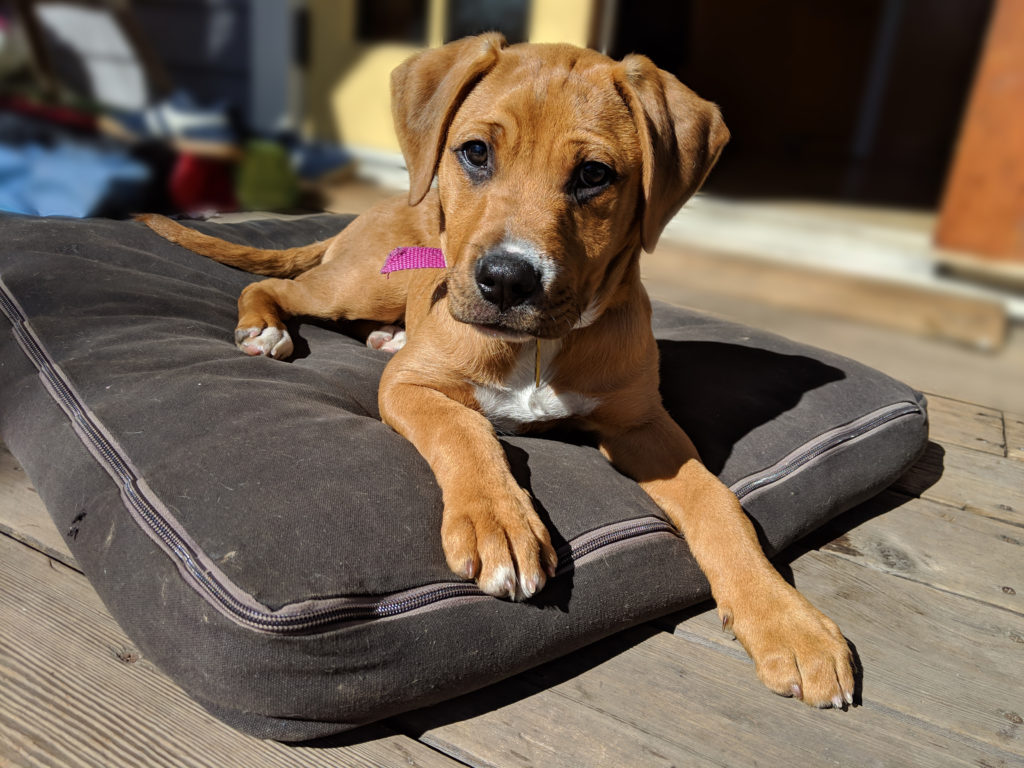Preparing for (and Surviving) a Puppy

Olive sleeping at 11 weeks old. For better or worse, bringing home a baby dog will change your life. Photo: Jennifer Chan ©2019
Unless you’ve done it before, it’s impossible to understand just how much a new puppy will change your life. This past January, my family fell in love with Olive, a nine-week-old lab mix rescued by Pets & Pals Animal Shelter in Lathrop, CA. Her mother is a purebred Labrador Retriever. All we know about her father is that he’s big and he jumped a high fence. Judging by her size at nine weeks old, the vet estimated that Olive might grow to 80 or even 100 pounds. We hadn’t planned on getting a big dog, but we couldn’t resist that brown-orange bundle with paws the size of pie plates.
We weren’t allowed to bring Olive straight home, so we had a few weeks to puppy-proof our house. We installed some dog gates, rehung the doors on our kitchen and bought a few gallons of enzymatic urine cleaner. The weeks came and went and we were finally ready…right? Not exactly. Bringing home a baby dog is similar to bringing home a baby human, albeit on a smaller scale. Suddenly, nobody in our family got to sleep through the night—every time we turned around, Olive was peeing somewhere new (but never outside). And who knew that puppies will chew walls? I can’t count the number of times I went to the pet store in those first few weeks, desperate for one solution or another.
Luckily, things have started to calm down over the past month. Olive sleeps through the night, goes on walks and even spends time in her crate without crying. Every day she becomes a bigger part of our family and we couldn’t imagine giving her up, no matter how many times she climbs on the kitchen table. Now that the dust has settled, here are a few things I’ve learned about having a puppy.
Puppies chew
“As soon as [puppies] start teething, everything is a chew toy,” says David Weiss, owner of Four Paws Pet Ranch. Save your clothes, furniture, walls and your puppy’s health by taking preventative measures. Make lots of fun and safe chew toys available at all times. Don’t give your puppy free reign of the house; instead, keep them confined to an enclosed area or room. If your puppy likes to chew immovable items like furniture or baseboards, try spraying the items with Bitter Apple (available at pet stores)—it’s nontoxic and puppies don’t like the taste.
If your puppy has already chewed baseboards, trim or drywall, repairing the damage may not be too difficult. A painter or handyman can usually make repairs without having to do expensive replacements.
Puppies pee
When Olive first came home at 11 weeks old, she had no idea that she was supposed to urinate outside. But even mostly housetrained puppies will likely have accidents until their bladders fully develop (sometime between four and six months old). Be prepared to take prompt action to protect your floors.
Whether your puppy has peed on hardwood or carpet, it’s important to blot the urine as quickly as possible. Next, spread baking soda, a vinegar mix or enzymatic cleaner on the spot. Let the cleaning solution soak for two to 15 minutes and then remove. Quick action will help keep the urine from staining or causing long-lasting odor.
In addition, as part of puppy-proofing, you can protect your hardwood floors by applying sealants or other protectants, which will guard against damage and make your floors easier to clean. A polyurethane sealant will coat the floor and make it less likely that scratches and spills will cause damage. Protect your carpet by applying Scotchgard every two to three months or purchasing stain-resistant rugs for the areas of your home where your puppy spends most of its time.

At 14 weeks old, Olive says, “Trouble? Me? I couldn’t possibly…” Photo: Jennifer Chan ©2019
Puppies roam
When it comes to fences for dogs, more is actually more. For the moment, we’ve erected a temporary yard enclosure while we plan the installation of a permanent, full-yard, dog-proof fence. It’ll have to be fairly tall. Installing a low fence that Olive can possibly jump is a great way to teach her to jump fences! Since she has fence-jumping in her genes, to play it safe, ours will probably be about eight feet tall.
In addition to jumping, dogs can climb and dig. Chain link fences look like ladders to some puppies, so we’ll probably install solid panel fencing instead. Some dogs like to tunnel under fences. Rocks at the base of a fence and reinforced ground fencing can thwart a digging escape.
If you already have a fence but need extra security, try adding coyote rollers or lean-ins at the top of the fence. Coyote rollers spin to prevent dogs (or coyotes) from getting a grip at the top. Lean-ins are secondary fences installed on top of your fence at an angle toward the ground.
Finally, despite our best efforts, escapes do happen. As David Weiss reminds us, make sure your puppy has a collar with a tag that includes its name, your address and up-to-date contact information. Do this even if your puppy is microchipped—not every facility has a microchip reader and it’ll make reunification that much easier. Also, a tag with your puppy’s name will be helpful if you decide to board your dog or have it attend doggy daycare.
Use Diamond Certified Resource to find top rated companies.
Local, Top Rated Diamond Certified Companies Related to Your Topic
Sonoma County Pet Boarding Companies
Related Articles
The Essential Guide to Pet Services
Get Expert Advice From Owners of Top Rated Local Companies
Become a Diamond Certified Preferred Member (Always Free)